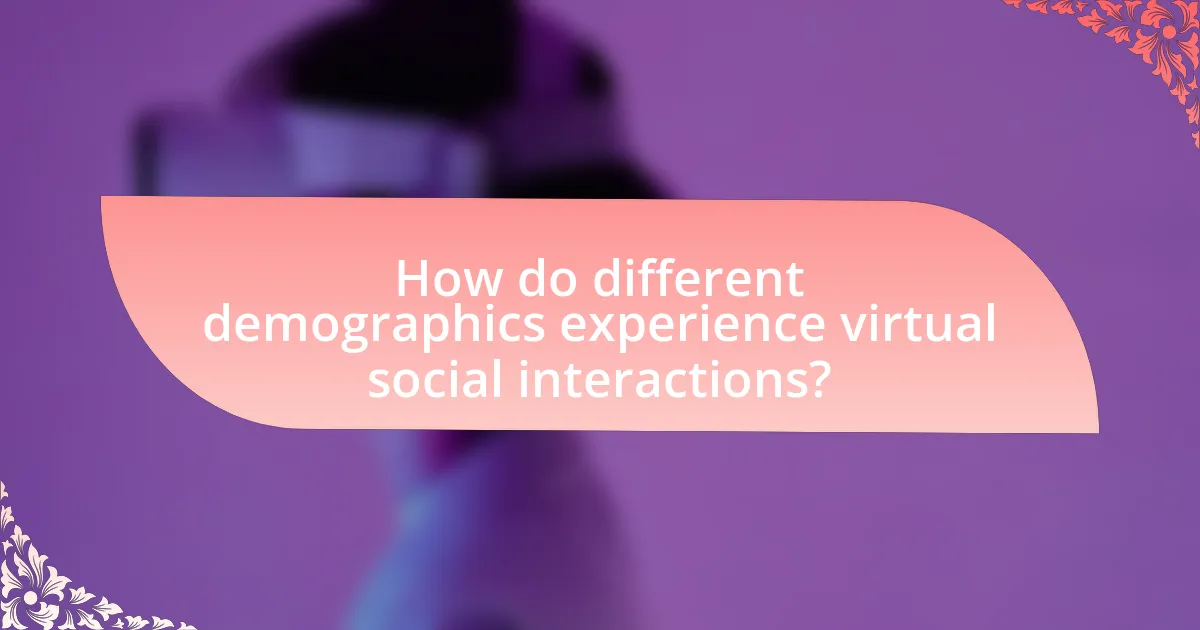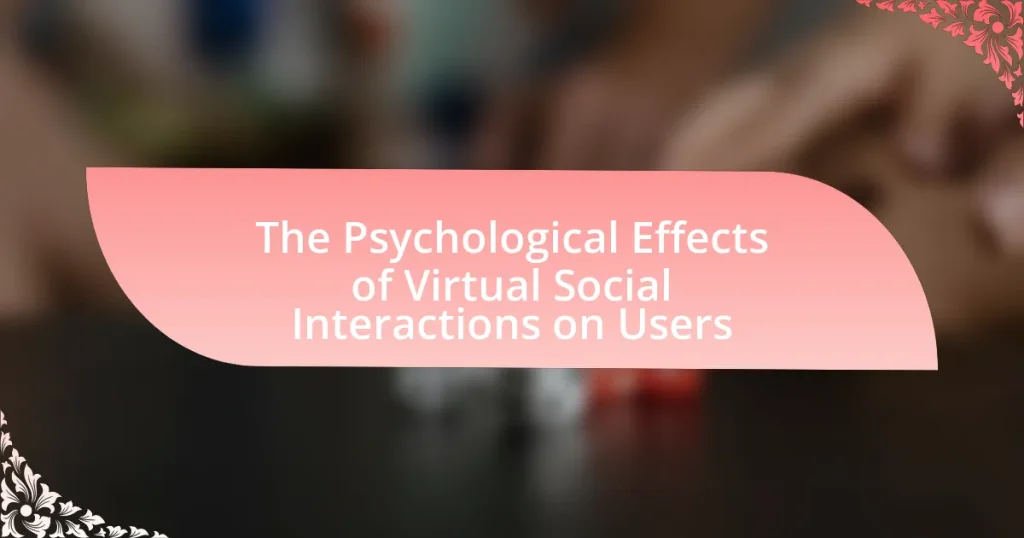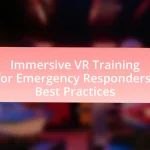The article examines the psychological effects of virtual social interactions on users, highlighting both positive and negative outcomes. It discusses how these interactions can enhance feelings of social connection and support, particularly for those feeling isolated, while also noting the potential for increased anxiety, depression, and loneliness due to social comparison and cyberbullying. Key differences between virtual and face-to-face interactions are explored, including the impact of non-verbal cues and asynchronous communication. The article further analyzes how demographic factors influence experiences with virtual interactions, particularly among adolescents and older adults, and offers strategies to enhance positive effects while managing mental well-being in digital environments.

What are the Psychological Effects of Virtual Social Interactions on Users?
Virtual social interactions can lead to both positive and negative psychological effects on users. Positive effects include increased feelings of social connection and support, as studies show that online interactions can enhance relationships and provide emotional benefits, particularly for individuals who may feel isolated in physical environments. Conversely, negative effects can manifest as increased anxiety, depression, and feelings of loneliness, especially when users engage in social comparison or experience cyberbullying. Research published in the journal “Cyberpsychology, Behavior, and Social Networking” indicates that excessive use of social media can correlate with higher levels of anxiety and depression among users, highlighting the dual nature of virtual interactions.
How do virtual social interactions differ from face-to-face interactions?
Virtual social interactions differ from face-to-face interactions primarily in the absence of physical presence and non-verbal cues. In virtual settings, communication relies heavily on text, audio, or video, which can limit emotional expression and reduce the richness of interpersonal connections. Research indicates that non-verbal communication accounts for a significant portion of human interaction; for instance, studies show that up to 93% of communication effectiveness can be attributed to non-verbal elements such as body language and facial expressions. This lack of physical cues in virtual interactions can lead to misunderstandings and a sense of emotional distance, impacting the quality of relationships. Additionally, virtual interactions often allow for asynchronous communication, which can alter the immediacy and spontaneity typical of face-to-face exchanges, further affecting social dynamics and emotional engagement.
What are the key characteristics of virtual social interactions?
Key characteristics of virtual social interactions include accessibility, anonymity, and the use of digital communication tools. Accessibility allows individuals to connect regardless of geographical barriers, enabling interactions across diverse locations. Anonymity can lead to more open communication, as users may feel less inhibited when their identity is concealed. Digital communication tools, such as social media platforms and messaging apps, facilitate real-time exchanges and the sharing of multimedia content, enhancing engagement. These characteristics contribute to the unique dynamics of virtual interactions, influencing users’ psychological experiences and social behaviors.
How do these characteristics influence user behavior?
The characteristics of virtual social interactions significantly influence user behavior by shaping their emotional responses and engagement levels. For instance, the presence of social cues, such as emojis and reactions, can enhance feelings of connection and belonging, leading to increased participation in online communities. Research indicates that users who perceive higher social presence are more likely to engage actively, as demonstrated in studies showing that platforms with rich social features see a 30% increase in user interaction compared to those with minimal social cues. This engagement is further influenced by the anonymity and reduced social pressure in virtual environments, which can lead to more open and honest communication, ultimately affecting how users express themselves and interact with others.
What are the positive psychological effects of virtual social interactions?
Virtual social interactions can enhance psychological well-being by fostering social connections, reducing feelings of loneliness, and improving mood. Research indicates that individuals who engage in online social activities report higher levels of social support and lower levels of depression. For instance, a study published in the journal “Computers in Human Behavior” found that online interactions can lead to increased feelings of belonging and community, which are crucial for mental health. Additionally, virtual platforms allow for the expression of emotions and sharing of experiences, contributing to emotional resilience and coping strategies.
How do virtual interactions enhance social connectivity?
Virtual interactions enhance social connectivity by providing platforms for individuals to communicate and engage regardless of geographical barriers. These interactions facilitate the formation and maintenance of relationships through instant messaging, video calls, and social media, allowing users to share experiences and emotions in real-time. Research indicates that 70% of people feel more connected to others through online interactions, as these platforms enable frequent communication and the sharing of personal milestones, which strengthens social bonds. Furthermore, virtual interactions can reduce feelings of isolation, particularly for individuals in remote areas or those with mobility challenges, thereby promoting a sense of belonging and community.
What role do virtual interactions play in reducing feelings of loneliness?
Virtual interactions significantly reduce feelings of loneliness by providing social connections that may not be available in physical environments. These interactions allow individuals to communicate, share experiences, and engage with others, fostering a sense of belonging. Research indicates that online communication can enhance emotional support and social engagement, which are crucial for mitigating loneliness. For instance, a study published in the journal “Computers in Human Behavior” found that individuals who engage in regular online interactions report lower levels of loneliness compared to those who do not. This demonstrates that virtual platforms can effectively serve as a substitute for in-person socialization, particularly in situations where physical interactions are limited.
What are the negative psychological effects of virtual social interactions?
Virtual social interactions can lead to several negative psychological effects, including increased feelings of loneliness, anxiety, and depression. Research indicates that individuals who primarily engage in online communication may experience a lack of meaningful connections, which can exacerbate feelings of isolation. A study published in the American Journal of Preventive Medicine found that higher social media usage correlates with increased rates of depression and anxiety among adolescents. Additionally, the constant comparison to others on social platforms can lead to diminished self-esteem and body image issues, as highlighted in research by the University of Pennsylvania, which showed that limiting social media use can significantly improve well-being.
How can virtual interactions lead to social anxiety?
Virtual interactions can lead to social anxiety by creating an environment where individuals feel pressure to present themselves perfectly and fear negative evaluation. This pressure is exacerbated by the lack of non-verbal cues, which can lead to misinterpretations and increased self-consciousness. Research indicates that individuals who engage primarily in online communication may experience heightened anxiety due to the constant comparison with curated online personas, as noted in a study published in the Journal of Social and Clinical Psychology, which found that social media use correlates with increased feelings of inadequacy and anxiety.
What impact do virtual interactions have on self-esteem?
Virtual interactions can significantly impact self-esteem, often leading to both positive and negative effects. Positive impacts include increased feelings of belonging and support, as individuals can connect with others who share similar interests or experiences, which can enhance self-worth. Conversely, negative impacts arise from social comparison and cyberbullying, where individuals may feel inadequate or rejected, leading to decreased self-esteem. Research by Vasalou et al. (2008) indicates that online interactions can amplify feelings of isolation if individuals perceive their virtual connections as superficial. Thus, the overall impact of virtual interactions on self-esteem is complex and varies based on individual experiences and the nature of the interactions.

How do different demographics experience virtual social interactions?
Different demographics experience virtual social interactions in varied ways due to factors such as age, gender, and socioeconomic status. For instance, younger individuals, particularly those aged 18-29, tend to engage more frequently in virtual interactions and report higher levels of satisfaction and connection compared to older adults, who may feel isolated or overwhelmed by technology. Research from the Pew Research Center indicates that 90% of young adults use social media, while only 40% of seniors do, highlighting a significant generational gap in engagement. Additionally, women often report feeling more comfortable in virtual social settings, using platforms for emotional support, whereas men may use them for networking and information sharing. Socioeconomic factors also play a role; individuals from lower-income backgrounds may have limited access to technology, affecting their ability to participate in virtual interactions. Thus, demographic variables significantly shape the experiences and perceptions of virtual social interactions.
What effects do virtual social interactions have on adolescents?
Virtual social interactions significantly impact adolescents by influencing their social skills, emotional well-being, and mental health. Research indicates that while these interactions can enhance social connectivity and provide support, they may also lead to increased feelings of loneliness and anxiety. A study published in the journal “Cyberpsychology, Behavior, and Social Networking” found that adolescents who engage heavily in online interactions often report lower levels of life satisfaction and higher levels of depressive symptoms. Furthermore, excessive reliance on virtual communication can hinder the development of face-to-face social skills, which are crucial during this developmental stage.
How do virtual interactions influence adolescent mental health?
Virtual interactions significantly influence adolescent mental health by affecting their social skills, self-esteem, and emotional well-being. Research indicates that excessive engagement in online platforms can lead to increased feelings of loneliness and anxiety, as adolescents may struggle to form genuine connections in a digital environment. A study published in the journal “Cyberpsychology, Behavior, and Social Networking” found that adolescents who spend more than three hours a day on social media are at a higher risk for mental health issues, including depression and anxiety. This correlation highlights the potential negative impact of virtual interactions on the mental health of adolescents, emphasizing the need for balanced online engagement.
What are the risks associated with virtual interactions for adolescents?
Virtual interactions for adolescents pose several risks, including exposure to cyberbullying, mental health issues, and privacy concerns. Cyberbullying can lead to significant emotional distress, with studies indicating that approximately 15% of high school students have experienced bullying online, which can result in anxiety and depression. Additionally, excessive screen time and social media use are linked to increased feelings of loneliness and low self-esteem, as reported by the American Psychological Association. Privacy concerns arise from sharing personal information online, which can lead to exploitation or harassment, further exacerbating the psychological impact on adolescents.
How do virtual social interactions affect older adults?
Virtual social interactions positively affect older adults by reducing feelings of loneliness and enhancing social engagement. Research indicates that older adults who participate in virtual interactions report higher levels of emotional well-being and social support. A study published in the Journal of Gerontology found that older adults who used video calls experienced a significant decrease in loneliness compared to those who did not engage in virtual communication. This suggests that virtual platforms can serve as effective tools for maintaining social connections, which is crucial for mental health in older populations.
What benefits do older adults gain from virtual social interactions?
Older adults gain several benefits from virtual social interactions, including reduced feelings of loneliness, improved mental health, and enhanced cognitive function. Research indicates that engaging in online social activities can lead to a 20% decrease in feelings of loneliness among seniors, as these interactions provide opportunities for connection and support. Additionally, studies have shown that regular virtual communication can improve mood and decrease symptoms of depression, contributing to overall mental well-being. Furthermore, participating in virtual social interactions can stimulate cognitive engagement, which is linked to better memory retention and cognitive health in older adults.
What challenges do older adults face in virtual environments?
Older adults face several challenges in virtual environments, including technological barriers, cognitive overload, and social isolation. Technological barriers arise from unfamiliarity with devices and software, which can hinder their ability to engage effectively. Cognitive overload occurs when the complexity of virtual platforms overwhelms their processing capabilities, making navigation difficult. Additionally, social isolation can be exacerbated in virtual settings, as older adults may struggle to form meaningful connections without face-to-face interactions. Research indicates that these challenges can lead to increased feelings of loneliness and anxiety among older users, highlighting the need for tailored support and training to enhance their virtual experience.

What strategies can enhance the positive effects of virtual social interactions?
To enhance the positive effects of virtual social interactions, individuals can employ strategies such as active engagement, regular communication, and the use of supportive technology. Active engagement involves participating in discussions and activities that foster connection, which has been shown to improve feelings of belonging and reduce loneliness. Regular communication, including scheduled video calls or group chats, helps maintain relationships and provides emotional support, as evidenced by studies indicating that consistent interaction can lead to increased well-being. Additionally, utilizing supportive technology, such as apps designed for mental health and social connection, can facilitate meaningful interactions and provide resources for users, thereby enhancing the overall experience of virtual socialization.
How can users create a supportive virtual environment?
Users can create a supportive virtual environment by fostering open communication, encouraging positive interactions, and establishing clear guidelines for behavior. Open communication allows users to express their thoughts and feelings, which can enhance emotional connections and reduce feelings of isolation. Encouraging positive interactions, such as compliments and constructive feedback, promotes a culture of support and inclusivity. Establishing clear guidelines for behavior helps to set expectations and create a safe space where users feel respected and valued. Research indicates that supportive online communities can significantly improve users’ mental well-being, as seen in studies highlighting the correlation between positive social interactions and reduced anxiety levels.
What practices can foster meaningful connections online?
Practices that can foster meaningful connections online include active listening, authentic communication, and shared experiences. Active listening involves fully engaging with others by acknowledging their thoughts and feelings, which enhances mutual understanding. Authentic communication, characterized by honesty and vulnerability, encourages deeper relationships as individuals feel safe to express themselves. Shared experiences, such as participating in online events or collaborative projects, create a sense of community and belonging. Research indicates that these practices can significantly improve emotional well-being and social satisfaction, as highlighted in studies on online interactions and their psychological impacts.
How can users manage their time spent in virtual interactions?
Users can manage their time spent in virtual interactions by setting specific time limits for each session. Research indicates that individuals who allocate designated time slots for online activities report reduced feelings of anxiety and improved focus. For instance, a study published in the Journal of Social and Clinical Psychology found that participants who restricted their social media usage to 30 minutes per day experienced lower levels of depression and loneliness compared to those who did not impose such limits. By utilizing tools like timers or apps that track usage, users can effectively monitor and control their engagement in virtual environments, leading to healthier psychological outcomes.
What are some best practices for maintaining mental well-being in virtual interactions?
To maintain mental well-being in virtual interactions, individuals should establish clear boundaries regarding their online presence and engagement. Setting specific times for virtual communication helps prevent burnout and promotes a healthy work-life balance. Research indicates that excessive screen time can lead to increased anxiety and stress levels, highlighting the importance of limiting virtual interactions to designated periods. Additionally, fostering genuine connections by using video calls instead of text-based communication can enhance emotional engagement, as non-verbal cues are crucial for effective communication. Studies show that video interactions can improve feelings of connection and reduce feelings of isolation, which are common in virtual settings. Regular breaks during virtual meetings also contribute to mental well-being, as they allow individuals to recharge and reduce cognitive fatigue.
How can users set boundaries to protect their mental health?
Users can set boundaries to protect their mental health by clearly defining their limits regarding online interactions and communication. Establishing specific times for social media use, limiting exposure to negative content, and communicating availability to friends and family can help maintain mental well-being. Research indicates that individuals who actively manage their online presence report lower levels of anxiety and stress, highlighting the importance of intentional boundary-setting in digital environments.
What resources are available for users struggling with virtual interaction effects?
Users struggling with virtual interaction effects can access various resources, including online support groups, mental health apps, and professional counseling services. Online support groups, such as those found on platforms like Reddit or Facebook, provide community support and shared experiences, which can alleviate feelings of isolation. Mental health apps, such as Headspace or Calm, offer guided meditations and coping strategies specifically designed to address anxiety and stress related to virtual interactions. Additionally, professional counseling services, available through teletherapy platforms like BetterHelp or Talkspace, connect users with licensed therapists who can provide personalized strategies to manage the psychological effects of virtual social interactions. These resources are validated by studies indicating that social support and professional guidance can significantly improve mental well-being in individuals facing challenges with virtual communication.
What practical tips can users implement to improve their virtual social experiences?
To improve virtual social experiences, users should prioritize active engagement by participating in discussions and showing genuine interest in others. Engaging actively fosters a sense of connection and belonging, which is crucial for positive psychological outcomes. Additionally, users can enhance their experiences by utilizing video calls instead of text-based communication, as visual cues significantly improve understanding and emotional connection. Research indicates that face-to-face interactions, even in a virtual format, lead to higher satisfaction levels compared to text-only exchanges. Furthermore, users should create a comfortable and distraction-free environment during virtual interactions to enhance focus and presence, which contributes to more meaningful conversations.

